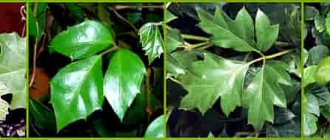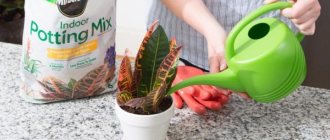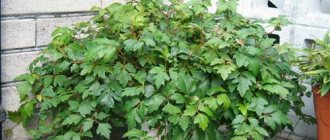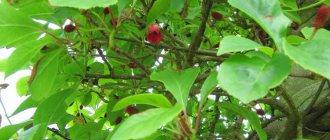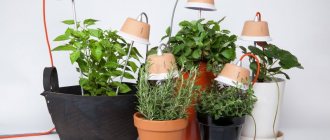Houseplants give your home a very special atmosphere, enliven rooms and make you feel closer to nature. They are also indispensable in work areas - any faceless and uncomfortable office will be transformed if it is slightly refreshed with the help of various ficus, vines or violets.
There is also a separate direction of design art, when, with the help of the right combination of indoor plants, an exclusive design is created, designed to emphasize the main idea of each specific room.
Birch is a houseplant that many green pet lovers have. She attracts with her unpretentiousness and ability to adapt to a wide variety of conditions.
What type of birch tree is it?
Birch is a houseplant belonging to the Cissus genus, which includes more than 350 species of shrubs, subshrubs and creeping vines. The genus name is the Greek word kissos, which translates as ivy. Cissus have nothing to do with ivy as a species, but are called so solely because of the similarity in appearance.
The most famous representatives of this genus of plants are cissus antarcticus, or, as it is also called, indoor grapes (a vine with large oblong dark leaves); cissus variegated (a liana distinguished by its richness of colors: stems are red-violet, leaves are green-red with a barely noticeable silver pattern) and cissus rhombifolia (birch).
Cissus rhombifolia is a widespread herbaceous vine with complex diamond-shaped leaves and thick brownish fluff on the stem. Birch flowers are small, collected in inflorescences in the axils, from which edible red berries later ripen. Unfortunately, at home, rhombifolia cissus does not bloom or bear fruit.
A little about the plant
Tropical cissus, or, as people call it, “birch”, is a close relative of grapes. The branches of this plant also hang down freely or can rise up if there is some kind of support. This plant looks very beautiful and is in great demand among designers. A cap of green foliage that curls and rises to the very ceiling will look amazingly beautiful in any room.
But this pretty liana is surrounded by many signs and superstitions, which do not always have a positive meaning. Such negative prejudices usually accompany all climbing plants. But each person decides for himself whether he should keep this unpretentious plant at home, which usually brings only positive emotions.
It is known that this fast-growing flower compares favorably with many other bindweeds. It has been proven that the juice of this ornamental plant does not contain any dangerous substances, but it does contain phytoncides that prevent pathogenic bacteria from multiplying.
Hand training helps: causes and prevention of “mouse” hand
Reading forums: things that young mothers waste time and energy on
Novosibirsk Tolmachevo Airport will be decorated with columns in the shape of airplane turbines
Reproduction
Is it possible to easily propagate ivy like birch? A houseplant of this species is very easy to propagate at home. To do this, you can use young shoots from the top of the plant with several internodes. They need to be placed in warm water to form roots or planted in special soil - a mixture of sand and peat. For better rooting, cuttings should be kept warm, at a temperature of 20 ° C.
For propagation, you can use not only apical shoots, but also unnecessary branches remaining after routine pruning of plants. Old and bare branches are cut off in the spring; this procedure is necessary so that the vine has an attractive appearance. After rooting, the shoots are transplanted into nutrient soil.
What problems might there be and how to solve them?
| Problem | Cause | Solution methods |
| The leaves are turning yellow | Irrigation violation. Lack of nutrients. | Regular watering. Feeding. |
| The appearance of brown spots | Sunburn | Protect from the sun in hot weather |
| The tips of the leaves dry out | Low humidity | Regular spraying |
| The leaves become smaller and the shoots become longer | Lack of light | Place the pot in a brighter place |
| Root system rotting | Improper care | Mandatory transfer |
| The appearance of powdery mildew | Excessive watering. High humidity. | Special product "Topaz" |
Light level and temperature conditions
Houseplants can be light-loving or shade-tolerant. The birch tree tolerates both sun and shade equally easily, but in general it is more inclined towards the latter. At the same time, it does not like direct sunlight, so if the pots indoors are on window sills, it is better to place them on a window on the north side.
You should never forget that the birch tree is a houseplant. Caring for it involves not only timely watering and replanting, but also knowledge of some of its features. For example, the fact that, unlike many indoor plants, the birch tree does not need to be moved to the balcony for the summer. This pet does not like drafts and does not welcome air baths in open space.
The optimal temperature in the warm season is from 18 to 25 ºС. In winter - no more than +16...+20 ºС, while when ventilating it is important to prevent cold air from entering the plant.
Seasonal care for cissus
| Season | Temperature | Lighting | Humidity |
| Spring | Despite their tropical origin, domesticated cissus plants are not so demanding of heat. Summer temperatures in the range of 19–25°C are quite suitable for the plant. | Cissus can safely be called a shade-tolerant plant that does not tolerate bright sunlight. But there are certain species, for example, cactus cissus, which need a brighter place and additional lighting in winter. Cissus plants develop well near windows facing western and eastern directions. The northern window sill is also appropriate. But a bright south window is unlikely to be suitable. The flower can grow in the back of the room under artificial light. But in this case, it must be illuminated at least 16 hours a day. In the summer, it feels great on a shaded balcony or veranda. | Due to the large foliage, cissus absorbs and releases a lot of moisture, so the air humidity should be high. The plant loves frequent spraying, especially in the hot season and when the central heating is on. It is very useful to sometimes put the cissus under a warm shower. By washing away accumulated dust, you help the plant to breathe freely. Spray only with well-settled or boiled water so that whitish stains do not remain on the leaves. During the cool period, until the heating is turned on, it is better to avoid spraying. |
| Summer | |||
| Autumn | In winter, cissus feels comfortable at temperatures from 15 to 18°C. Antarctic cissus prefers a cooler room - from 10 to 12°C. It will also withstand a drop to 5°C, but not more than 2-3 days. Cissus multicolored is more thermophilic - the lower temperature limit is 16°C. In winter, be sure to protect the plant from cold drafts, otherwise the cissus can easily shed its leaves. | ||
| Winter |
Watering mode. Humidity
Birch is a rather unpretentious houseplant and easily adapts to many negative factors, but not to lack of water. The vine should be watered abundantly, but carefully. She does not like excessive moisture and stagnation of water in the pot, and even more so the soil should not be allowed to turn into a dry lump of earth. It is believed that a birch tree needs to be watered every day in summer, and 2-3 times a week in winter, but this is a controversial point. In summer, when the temperature is fairly low and even, the plant may not need to be watered for 2-3 days, but in winter, with active heating, the soil can dry out within a day. So watering indoor plants needs to be adjusted to specific conditions.
But what Cissus rhombifolia will never refuse is a warm shower. Birch, for all its immunity to mild temperature fluctuations, does not tolerate low air humidity. This phenomenon is smoothed out with the help of water procedures: a small plant is watered from the shower in the bathroom, and long vines, which are difficult to move, need to be sprayed more often.
What to do after purchasing a plant?
After purchasing the roisissus, you must carefully transport it to your home without damaging the crown. Upon arrival home, free it from the transport substrate.
For replanting, it is better to choose loose soil filled with nutrients, the base of which consists of turf and deciduous soil. It is better to add humus, leaf mixture or peat-sand mixture to loosen the soil.
A pot should be chosen 6 centimeters larger if the root system is entangled in earth clods. It is up to the owner to decide which pot to choose – plastic or ceramic. Both materials have their pros and cons:
- In a plastic pot, there is a high risk of waterlogging the soil, as it limits the evaporation of water from the pot. The root system suffers primarily from such watering.
- A ceramic pot allows water to pass through, unlike a plastic one, but because of this the plant will have to be watered more often.
As the plant grows, the pot needs to be replaced with a larger one.
How to fertilize correctly
The most intensive growth of the birch tree occurs in the summer, so it needs additional nutrition at this time of year. Fertilizing is done with universal complex fertilizers for houseplants approximately once every 2-3 weeks. In addition, in spring and summer, a complex agent for growth and increase of green mass is added to the spraying water. It is also used once every 2-3 weeks. It is important to know that you cannot fertilize and spray with water and the preparation at the same time, as this can cause burns on the foliage and roots.
How to care at home?
Lighting
Cissus rhombifolia grows best under bright, indirect light . This plant should not be placed in open places where the sun shines all day long, for example, on a balcony. Due to direct exposure to sunlight, birch leaves can burn.
The soil
There is no need to use special soil for the growth of cissus. You can use regular primer, which is sold in every store. But you can also make the soil yourself. To do this you need:
- Peat (1 part).
- Turf (1 part).
- Sand (1/2 part).
- Leaf soil (2 parts).
- Earth (1 part).
- Perlite or vermiculite.
The soil for birch trees must be water- and breathable. To ensure this, add perlite or vermiculite to the soil.
Temperature
The most favorable temperature for the growth of roiscissus is +17 +25°C , in winter - no more than +16°C . If the apartment is hot, the culture can easily adapt. During the heating season, the birch tree may shed some of its leaves, but with the change of season the leaves will be restored.
Air humidity
Birch grew in tropical forests, so it prefers high air humidity . It is necessary to regularly spray the plant, bathe it under warm water, or wipe the leaves with a damp cloth to remove dust.
In the winter season, the birch tree crown needs to be sprayed twice a week, and in the summer every day. Cissus can also be bathed in the bathtub. To prevent the soil from becoming waterlogged, you need to cover the pot with plastic wrap.
Watering
Birch needs frequent and abundant watering , but without stagnation. The water needs to sit for a while so that all the impurities come out and it becomes softer. In winter, the plant can be watered much less, provided the room is cool. If the room is hot, then you need to water it, just like in the summer.
Feeding and fertilizers
Feeding is done once every 2 weeks from March to October, the rest of the time no additional nutrition is required.
An infusion of chamomile or drunken tea is suitable for feeding. They contain the necessary nutrients for growing. With their deficiency, not only growth slows down, but the leaves of the plant begin to turn yellow. If there is no dormancy in winter, fertilizing should be done at least twice a month.
Fertilizer should be added to the water every two weeks. These can be any mixtures for ornamental foliage plants that can be found in a gardening store.
Trimming
50-100 cm per year , so it is extremely important to trim it. This helps create the shape of the flower and remove weak, damaged shoots, which in turn encourages more side branch growth.
Peace
For a birch tree that grows at home, it is important to properly organize the dormant period. With the onset of the winter season, the pot is moved to a cooler room, where the air temperature is +15°C . Water the flower less often and not so abundantly.
Bloom
Birch trees bloom in their natural environment in early summer. During this period, inconspicuous flowers appear, which are collected in an inflorescence - an umbrella. At home, the birch tree practically does not bloom.
Transfer
In the first three years, the birch tree is replanted annually. Then transplants are carried out every 2-3 years . It is important to transplant a young plant correctly:
- You need to carefully remove the flower from the old pot without damaging the root system.
- Approximately 3 centimeters of drainage and soil should be placed at the bottom of the new pot. After this, you can lower the plant there.
- Next, fill the space with soil, water and compact the soil thoroughly.
Reproduction
Two methods are used for reproduction:
Cuttings:
- It is held in any season of the year.
- It involves cutting off the top of a shoot with several buds and rooting it in the ground.
- The suitable temperature for rooting is +20°C.
Bush division:
- A plant older than three years is divided into several parts and planted in other pots.
- The roots are cut with a sharp instrument.
It is best to use the first method, that is, cuttings. To do this, use a knife to cut a stalk about 10 cm long, and then place it in a jar of water. Rooting usually takes about three weeks. After new roots have formed, the cuttings need to be planted in pots and watered regularly.
How to replant a birch tree
Cissus rhombifolia needs to be replanted in the spring, but this procedure is not necessary every year. As a rule, a birch tree is replanted every third year, and the rest of the time the soil is simply loosened well and filled with fresh soil.
A slightly larger pot is taken to accommodate the increased mass of roots. The container should be ceramic: recently, plastic flowerpots have been increasingly used, which is not entirely correct, since they do not allow air to pass through, and the soil in them becomes sour, because evaporation is only superficial.
At the bottom of the container you need to lay a layer of drainage 2 cm thick. Then the pot is filled with soil to 1/3 of the volume and the roots of the plant are laid. Then they are sprinkled with earth: the roots should lie at a depth of at least 2-3 cm from the surface. The soil on top is not compacted.
You can buy the soil mixture in the store (consultants will recommend the right option) or prepare it yourself. To do this, you need to take two parts of turf soil, two parts of humus, two parts of sheet soil and one part of coarse sand to improve drainage properties.
Feng Shui meaning
If you turn to Eastern teachings for the meaning of cissus, you will find out that this climbing flower symbolizes wisdom and life experience. It is able to endow owners with such traits as perseverance, determination, and instill confidence in their abilities.
It is also believed that the owner of a house in which an indoor “birch tree” grows easily remembers information and is open to acquiring new knowledge and skills. The owner of such a plant usually always strives to get to know the world around him and understand it. Those who have such a plant at home have a simpler attitude towards everyday problems and the troubles that happen in their lives.
Birch (houseplant): diseases and pests
One of the most common pests for birch trees is spider mites. It appears in conditions of low air humidity. Another widespread “freeloader” is the leaf aphid, which is clearly visible when you carefully examine the back of the leaves. You can get rid of both pests by washing the plant with a soapy solution (10 g of laundry soap per liter of warm water). If this does not help, then an insecticide can easily cope with the problem.
How can a birch houseplant get sick? The leaves dry out, wrinkle and turn brown - this is not a disease, but insufficient air humidity. The plant needs to be sprayed and bathed more often. Is the plant wilting and looking unhealthy? You need to take a closer look at the roots: perhaps they are suffering from root rot due to excessive watering. In this case, removing part of the rotted root system and replanting it in new healthy soil will help. Leaf mold occurs due to poor drainage.
Possible pests of rhoicissus and problems in cultivation
It can be affected by scale insects, aphids, spider mites, mealybugs and various rots. When pests appear, the plant must be treated with insecticides. When roots or stems rot, fungicides are used. Problems include:
- whitish spots on the leaves appear from sunburn;
- stretching of shoots and small leaf plates indicates a lack of lighting;
- Yellowing of leaves and their shedding occurs due to a lack of nutrients or a small dose of watering.
Possible problems in growing birch trees
It is easy to determine why certain metamorphoses occur with roisissus, since the plant reacts to changes in the microclimate of the room.
What diseases and parasites can affect a flower:
- Lack of humidity often leads to the appearance of fungal diseases that can affect the above-ground and underground parts of the specimen.
- Poorly disinfected soil can become the basis for the appearance of scale insects and dust mites.
- If the leaves begin to dry, then infection with root rot is possible. This problem occurs if the substrate does not allow air to pass through, there is no drainage and excess water stagnates in the pot.
- A frequent “guest” is powdery mildew. But the disease can only affect plants that are weakened after a sharp temperature change.
Diseases of indoor birch
Crohn's can be treated with a soap solution against any type of parasites and infections, but if the form of the disease is not advanced. If this does not help, then special means must be used to combat the disease.
The decorative version of roisissus is an ideal option for breeding by inexperienced gardeners who want to decorate their home with a floral arrangement. An ideal option for such a plant would be a house with “tropical” climate conditions. The plant does not require special care; it reproduces using the elementary method.
Some tips
- In order to form a beautiful bush, you need to pinch the shoots.
- In winter, moldy fungus very often appears on the roisissus, and it also rots easily during this period.
- In winter, it is necessary to move the vine to a place where it will be cool, and also to significantly reduce watering. During this period, she experiences a period of rest.
Myths about ivy
What interesting things can you tell about this type of ivy, like birch? Is it possible to keep a houseplant at home if so many scary fairy tales have been invented about it? Popular superstitions say that ivy (and all similar plants) should not be kept at home, as they survive men. And not just all males, but husbands. Later, this legend was transformed: they began to believe that ivy in the house is a sign of divorce, usually due to infidelity.
Currently, the birch tree has become more attractive from the point of view of the field of subtle spheres: it is believed that cissus promotes creativity, the emergence of new ideas, and increased immunity.
The last statement is also true from a purely scientific point of view - in addition to its decorative function, birch improves the ecology of the room: it purifies and humidifies the air, kills harmful microorganisms and absorbs some harmful substances, for example, formaldehyde. So you can safely keep a birch tree at home.
Trimming
Pandanus flower - what kind of houseplant?
Homemade birch in a pot is an ideal plant option for those who like to experiment and create. Thanks to pruning, you can form a crown.
Branches that have become partially bare, shedding their foliage, as well as unsightly growing parts of the shoots, must be removed. You can remove those parts of the crown that do not fit into the shape of the plant. It is not advisable to remove many parts at the same time.
Formation of the cissus crown
The procedure is carried out as follows:
- Prepare tools: sharp pruning shears, activated carbon powder.
- Identify items that require removal.
- Cut the shoots with pruning shears, making 1 precise cut.
- Treat affected areas with activated carbon powder or plant antiseptic.
Important ! The procedure should be carried out in early spring, before the specimen enters the active growth phase. If necessary, you can do pruning in the summer, but in smaller quantities.
